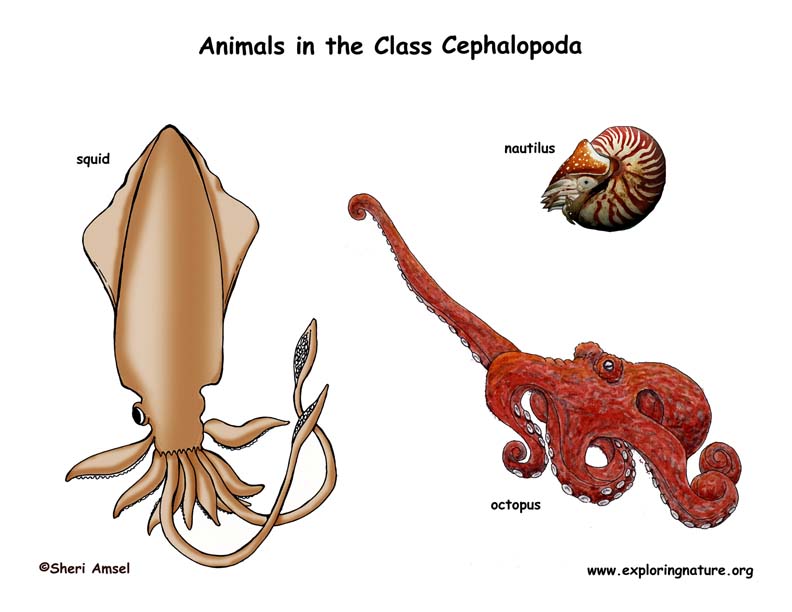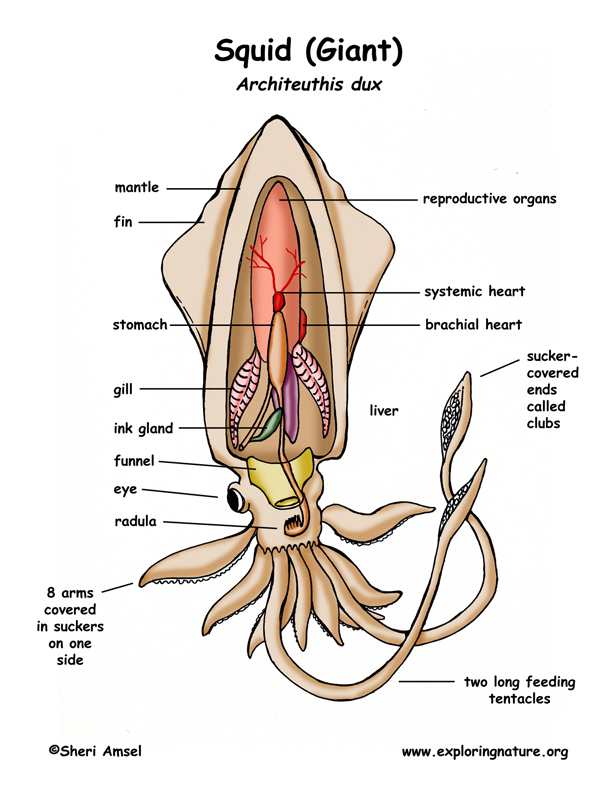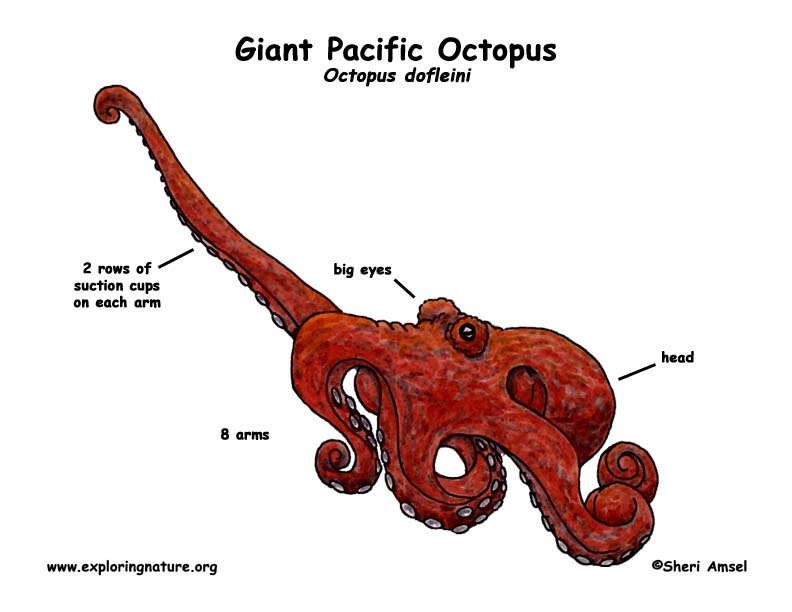

The Cephalopods
The Cephalopods (Class Cephalopoda) include squid, octopus and nautilus. Their name Cephalopoda means “head footed.” They are all fast moving ocean animals.
Habitat: They are all found in the ocean.
Physical Traits: They have a series of arms or tentacles that circle the “head.” Each arm has two rows of suction cups. |• Though the octopus has eight arms, some Cephalopoda have a mixture of arms and tentacles. Some having up to a 100 tentacles.
• Cephalopods have a relatively complex brain and eyes with good, color vision. They are thought to be quite intelligent and able to learn from experience.
• Squid and octopi have a funnel structure, called a hyponome, through which they can blow water to move themselves quickly along.
• Many species have ink to release if threatened and can change color to escape predators.
• The nautilus has a shell to protect it.
• Squid have a skeleton.
• The Octopus has neither.
Diet: They are predators, using their arms (or tentacles) to trap prey, and a sharp beak to bite prey. They then stuff prey into a central mouth.
________________________________________________________________________________________________________________________________
They are found throughout all the oceans and are thought to live in the deep, water habitats along the continental shelf and offshore islands, preferring cold, temperate oceans though not polar waters. They are rarely found in tropical ocean habitats.
The giant squid holds many size records. They are not only the biggest squid, but are the biggest animal in their Phylum – Mollusca. They are also thought to be the largest invertebrate in the ocean, reaching up to 60-feet long (18 m) and weighing up to a ton (2,000 pounds – 900k). Females are larger than males.
They have a body with fins, a head, a sharp beak, 8 arms covered in suckers on one side, and the two long feeding tentacles. The tentacles are much longer than the rest of the body reaching up to 40 feet long (12m), the tips covered in suckers. These sucker-covered ends are called their “clubs.” They have large eyes, each the size of a dinner plate (again the largest on Earth) and excellent vision. They also have a brain and are thought to be intelligent. They have gills for breathing and an ink sac for spraying dark-colored ink when escaping predators. They use their muscular mantle to shoot water out through the funnel for a quick escape.
Very little is known about their habits, because it is very difficult to view a live giant squid.
They eat fish and other squid, grabbing them with the suction clubs on the end of the tentacles and pulling them into their legs. Once gripped in their legs, they can stab them with their sharp beaks before stuffing them into their mouth. Prey is further broken down by the radula, the rasping structure lined with sharp, little teeth. Once the food is shredded, their muscular tongue helps direct it down the digestive tract.
Only the sperm whale has been found to have giant squid in its digestive tract on a regular basis.
Females are thought to be able to produce a million tiny eggs. As with all invertebrates, most of these hatching young are probably eaten by predators. The surviving young grow quickly, probably reaching adult sizes in less than 2 years. Rapid growth helps them outgrow any potential predators, who might eat them.
They are found in the northern Pacific Ocean from Alaska south to southern California and across the Pacific to Japan on the ocean floor.
They are reddish-brown with eight arms and 2 rows of suction cups lining the bottom side of each. They can change color when they are excited and to blend in. They weigh about 75 pounds, though some much larger have been found on occasion. They have no skeleton, so can squeeze through very small spaces. They do have a hard beak that they use to drill through shells to get at the soft body of their prey.
The octopus can crawl along the ocean floor on their arms or swim by shooting water out of their bodies to move forward. They can squirt ink to escape attack by a predator. They can be eaten by other octopuses, fish, sharks, and dolphins.
They eat crabs, clams, scallops, snails, fish and other octopuses. The octopus uses its sharp beak to kill, and break prey apart for eating. They can send out a toxin that will stun prey and begins to break them down to they can be eaten.
Females lay up to 100,000 eggs in a rock den. She cleans and blows air over her eggs until they hatch in 5 -7 months. After they hatch the female dies. Baby octopuses are as tiny as a sunflower seed.
When you research information you must cite the reference. Citing for websites is different from citing from books, magazines and periodicals. The style of citing shown here is from the MLA Style Citations (Modern Language Association).
When citing a WEBSITE the general format is as follows.
Author Last Name, First Name(s). "Title: Subtitle of Part of Web Page, if appropriate." Title: Subtitle: Section of Page if appropriate. Sponsoring/Publishing Agency, If Given. Additional significant descriptive information. Date of Electronic Publication or other Date, such as Last Updated. Day Month Year of access < URL >.
Amsel, Sheri. "Class - Cephalopoda (Nautilus, Squid, Octopus)" Exploring Nature Educational Resource ©2005-2025. January 14, 2025
< http://www.exploringnature.org/db/view/Class-Cephalopoda-Nautilus-Squid-Octopus >



